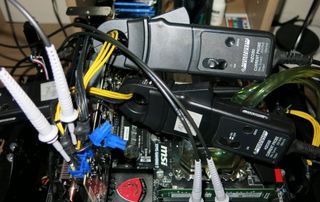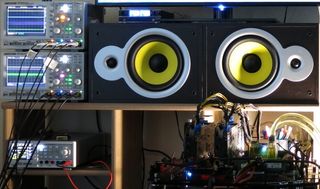The Math Behind GPU Power Consumption And PSUs
The End Of A Long Journey
The usual more-is-better rationale of PSU output can’t be upheld here. As is so often the case, the important consideration is good balance. Spikes in power consumption demonstrated by modern graphics cards (and illustrated by us) need to be seen for what they are: a challenge to the quality of a PSU, not its maximum wattage. If you want to be protected from bad surprises and potential long-term damage, then good quality is what you need. And the decreased efficiency of oversized PSUs at idle shouldn’t be ignored either.
So, what should an ideal PSU for today’s powerful graphics cards look like, and how should it be measured?

The average power draw under load over a certain period of time, as well as the power consumption of the rest of the system, are the only measurements that are really important in PSU selection, not the brief spikes. You've hit the ideal power range if the sum of all components amounts to approximately 75 percent of the maximum capacity during a stress test.
Component quality makes for an interesting story, too. It needs to be stressed that a great brand name just isn’t everything. What’s important is that the capacitors in question are suitable for the task at hand. So, the type and features of the capacitors used on the secondary side are what really need to be evaluated.
The statement that a PSU uses capacitors made exclusively in Japan might make for great marketing, but it doesn’t necessarily make for a great PSU. This is where the spikes we discussed come into play. They're what ultimately determine how consistent the supply will be and how long the components will last.

You can learn a lot by measuring a lot. This is my personal mantra that will stick with me after this year-long journey. After a lot of direct contact with graphics card and PSU manufacturers, talks with their development departments and even visits to their factories, I have personally achieved a much clearer picture of the many problems and how they relate to each other. This has been a slow, steady and certainly worthwhile process.
In addition, the cooperation with the measurement equipment manufacturers has done its part to find the origins of several problems. This is why I’d like to publicly thank all participants, yet again. It’s not a sign of weakness to profit from other people’s knowledge, but being too proud to ask certainly is.
Along those lines, it would certainly be helpful if PSU reviews didn’t just use Chroma protocols and ohm loads, but created the same spikes that are delivered by the actual technology that PSUs need to contend with. That’s going to be the point when puzzling and hard-to-measure problems such as lost Power Good signal flags from the motherboard are finally a thing of the past. After all, one thing's for sure: many hard-to-explain PSU failures and system power losses have simple explanations, namely the extremely fast load fluctuations with their high peaks, PSUs that didn’t take them into account in their design or the selection of suitable capacitors and, finally, the wrong PSU choice.
In summary, after a whole year, I’ve finally arrived where I meant to be after a few weeks. In hindsight, this was never realistic. However, the long and arduous journey has provided both the cause and the motivation for many insights and interactions that I was able to collect on the way, and I’d never have had them otherwise.
Current page: The End Of A Long Journey
Prev Page Good Caps Or Bad Caps? The Legend Of The Japanese DragonStay on the Cutting Edge
Join the experts who read Tom's Hardware for the inside track on enthusiast PC tech news — and have for over 25 years. We'll send breaking news and in-depth reviews of CPUs, GPUs, AI, maker hardware and more straight to your inbox.
-
Vorador2 Man, everytime i'm truly fed up with Tom's posting news that read as press releases, and badly written opinionated pieces, a jewel of a deeply researched original article shows up.Reply
Thanks for reminding me of the reasons i started reading Tom's Hardware. -
FormatC It is always difficult to break down the complex content to find an understandable level for all. We may lose a lot of information by this way (and some experts and nitpickers will kill me) or write boring and extra dry stories for a handful of readers without simplifications. It is always hard for us to find a good compromise.Reply
This equipment, shown in the review, is a good basement for a lot of other in-dept reviews in Germany, like the efficiency analysis of Nvidias GeForce GTX 970. You simply need exact numbers to do this. :D
I've also visited PSU manufacturers in Asia this year and this VGA-PSU problem is now more in focus...
But all this are another stories and I hope, that we get for all this more translation capacity here in US/UK. If not: it is a good reason to learn German :D
-
gofasterstripes Tom's Hardware delivers another piece of technical journalism at the gold standard.Reply
Well done to all involved, thank you. -
s3anister This was an excellent read; thank you for the incredible amount of work done for this article.Reply -
justin2003jclc Hi Toms Hardware,Reply
Can you clarify on your rule number3 ? Do you means that most of the PC PSU in the market are linear power supply when you mention about analog? Do you mean that there is only minorities of PC PSU available in the market are using switching power supply design? -
This is GOLD! Kudos to Igor for writing such a superb article. I hope he makes all the PSUs he reviews, undergo the same tests. Can't wait for his PSU reviews :)Reply
-
pecul1ar Congratulations on finishing this year long experiment, and thank you for sharing us your findings. This must have lifted a load off your shoulders..Reply
Oh, so this was translated? Thank you for that as well :) -
NoShot So, my take away from this is my PC builder (will not name here but is one of the larger ones offering custom builds) mislead me on their configuration setups when they said a Corsair RM850 PSU would be fine for a r9 295x2 and a i7 4970k. Not surprisingly, I am having random issues with this build where the 29 295x2 would only activate one GPU after system reboot or awake from sleep mode. I was thinking it was a driver issue, but looks like I need to drop a couple hundred dollars on a replacement PSU.....great. Genuine thanks for the article though.Reply
